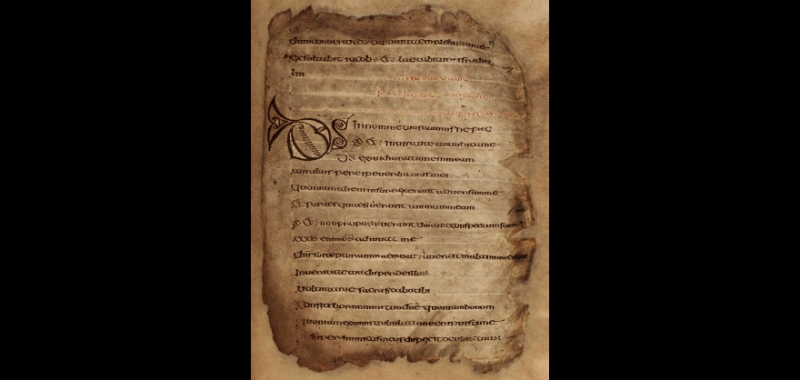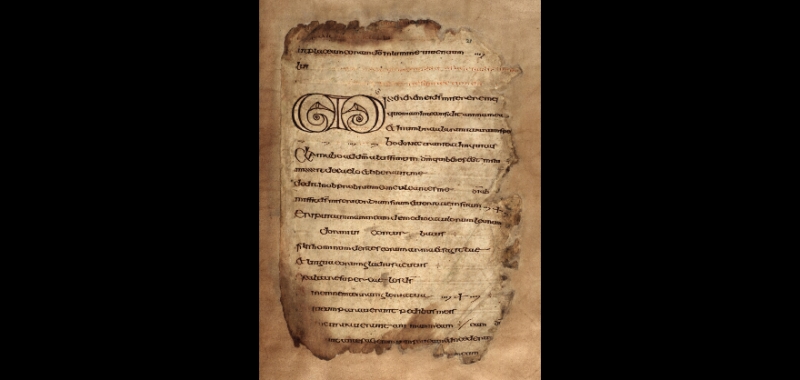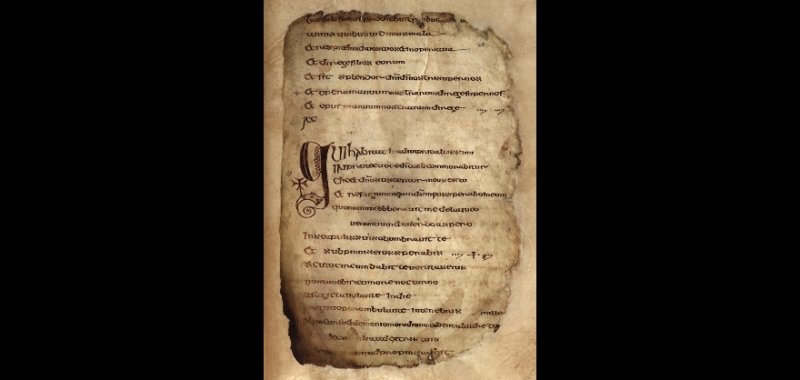The Cathach / The Psalter of St Columba
RIA MS 12 R 33 c. A.D. 560-600 Vellum: 27cm x 19cm 58 leaves (original c. 110 leaves)
The Cathach is the oldest extant Irish manuscript of the Psalter. It may also be the earliest example of the form of Irish writing known as insular majuscule script. The surviving portion of the manuscript contains a Vulgate version of Psalms XXX (10) to CV (13) with an interpretative rubric or heading before each psalm. It is written in Latin.
It is traditionally ascribed to St Columba (Colum Cille) as the copy, made at night in haste by a miraculous light, of a Psalter lent to Columba by St Finnian. A dispute arose about the ownership of the copy and King Diarmait Mac Cerbhaill gave the judgment ‘To every cow belongs her calf, therefore to every book belongs its copy’. The arbitration failed and the controversy led to the battle of Cúl Dreimne in AD 561, where an alliance of northern septs defeated King Diarmait. St Columba left Ireland and went to Iona in AD 563, perhaps exiled as punishment for the lives lost in the battle. It is possible to date the manuscript to the late 6th or early 7th century from the script, but modern historical scholarship has cast doubts on St Columba's authorship.
The story of the circumstances in which St Columba’s manuscript was produced was written down in the early sixteenth century by Manus O’Donnell, in his new life of the saint who was patron of his kin group (O’Kelleher & Schoepperle, 1918; Lacey, 1998). The story is sometimes cited as the earliest example of copyright, but it reflects attitudes to manuscript ownership in the sixteenth rather than the sixth century.
The script, in the hand of a single scribe, is early majuscule with ornamental capitals, some of which are in red and, like the red in the lettering for the rubrics, the colour has faded. The beginning of each new psalm is indicated by an ornamental capital. The framework of the capitals is often outlined by a series of scarlet dots and the decoration consists mostly of spirals and animal heads. The capitals do not stand out from the text but are drawn in by a series of letters of diminishing size (Herity & Breen, 2002).
Between 1062 and 1098 a special cumdach or shrine was made to protect the vellum manuscript, which may already have become fragmentary (Ó Floinn, 1995; 1997; Ó Cróinín, 2009). In the later Middle Ages the Psalter was in the possession of the O’Donnells but in the custody of the Mac Robhartaigh family at Ballymagroarty, Co. Donegal. It became known as the Cathach’ or ‘Battler’ from the O’Donnell practice of carrying it thrice right-hand-wise around the field of battle as a talisman.
The Cathach was probably taken to France in 1691 by Colonel Daniel O’Donnell (1665–1735) of Ramelton. In 1723 he had the book-shrine refurbished and added an inscription to that effect. He also had the O’Donnell arms engraved on the front of the shrine. Before his death, the Colonel is said to have deposited it in an Irish monastery in Flanders being unable to identify the rightful owner. It was brought back to Ireland by Sir Capel Molyneux and given to Sir Neal O'Donel of Newport, Co. Mayo, either in 1802 or 1813 (Herity, 2000). The manuscript was re-discovered inside the shrine in 1813 when the cumdach was opened by Sir William Betham. The book-shrine, with the vellum manuscript inside, was deposited in the Academy by Sir Richard O'Donel in 1843. A full transcript of the surviving text of the manuscript was published in the Proceedings of the Royal Irish Academy in 1916.
The leaves when taken from the casket were caked together and cockled. In 1920, in the British Museum bindery, the leaves were separated and mounted in paper frames and the butt joints were overlaid with white net. In 1980–1 more elaborate repair and rebinding work was carried out by Roger Powell and his assistant, Dorothy Cumpstey, at a cost of Stg£6,150 for the repair and Stg£250 for the case. The paper mounting, from which the vellum leaves had come adrift, was replaced by new vellum mounts specially stained to match the colour of the original leaves. Pieces of degreased fish skin were used for joining butted edges in the vellum mounts. The leaves, assembled in sections, were sewn within a zig-zag of hand-made paper onto cords and bound in English oak boards. The spine was covered in white alum-tawed pigskin. To keep the vellum under pressure and to prevent cockling, the rebound manuscript was put into a special box designed by David Powell and made by George Taylor in Edward Barnsley's workshop.
The Cathach was published in CD-ROM format by the Academy in 2002.
Each vellum page of the Cathach has been digitized for the Irish Script on Screen project for publication online in 2021, believed to be the 1500th anniversary of the birth of St Columba.
The late 11th-century shrine (cumdach) of the Cathach, made by Sitric of Kells, Co. Meath to the order of Cathbarr O’Donnell, may be seen in the National Museum of Ireland, having been transferred there from the Royal Irish Academy in the 1930s.
Select Bibliography
- Alexander, J.J.G. (ed.), Insular manuscripts, 6th to 9th century (London, 1978), 28–9.
- Betham, William, Irish antiquarian researches (Dublin, 1827), 107–21.
- Bourke, Cormac (ed.), Studies in the cult of St Columba (Dublin, 1997).
- Brown, T. Julian, ‘The Irish element in the insular system of scripts to circa A.D. 850’ in H. Lowe (ed.), Die Iren und Europa im früheren Mittelalter (Stuttgart, 1982), 101–19.
- Brown, T. Julian, 'The oldest Irish manuscripts and their late antique background', in P. Ní Chatháin & Michael Richter (eds), Ireland and Europe: the early church (Stuttgart, 1984), 311–27.
- Byrne, F.J., A thousand years of Irish script: Catalogue of an exhibition of Irish manuscripts in Oxford Libraries (Oxford, 1979).
- Cunningham B., & Fitzpatrick, S., Aon amharc ar Éirinn: Gaelic families and their manuscripts (Dublin, 2013), 33.
- Douglas, Chrétien. The Battle Book of the O’Donnells (Berkeley, 1935).
- Esposito, Mario, ‘The Cathach of St Columba’, Louth Archaeological Journal, 4 (1916–20), 80–3.
- Hennessy, W.M. & Kelly, D.H. (ed. & trans.) The Book of Fenagh (Dublin, 1875).
- Henry Françoise, ‘Les débuts de la miniature irlandaise’, in F. Henry & G. March-Micheli, Studies in early Christian and medieval art (3 vols, London, 1983-5), ii, 25-7.
- Herity, Michael & Breen, Aidan, The Cathach of Colum Cille: an introduction (Dublin, 2002).
- Herity, Michael, ‘The return of the Cathach to Ireland: conflicting accounts of the repatriation of the Cathach from the continent’, in Alfred P. Smyth (ed.), Seanchas: studies in early and medieval Irish archaeology, history and literature in honour of Francis J. Byrne (Dublin, 2000), 454–64.
- Hourihane, Colum, Gothic art in Ireland, 1169-1550: enduring vitality (New Haven, 2003).
- Kenney, J.F. Sources for the early history of Ireland: I. Ecclesiastical (New York, 1929), 638–9.
- Lacey, Brian (ed.), The life of Colum Cille, by Manus O’Donnell (Dublin, 1998) [Includes a modernised English translation the ‘copyright’ story, slightly abridged, pp 97–8.]
- Lawlor, H.J., ‘The Cathach of St Columba’, Proceedings of the Royal Irish Academy, 33 C 11 (1916–17), 243–443. [Contains a full transcript of text of the Cathach]
- Löwe, E.A. (ed.), Codices Latini antiquiores (2nd ed. Oxford, 1972), No. 266.
- McNamara, Martin, ‘Psalter text and psalter study in the early Irish church (A.D. 600–1200)’, Proceedings of the Royal Irish Academy, 73 C 7 (1973), 264–9.
- Ó Cochláin, R.S., ‘The Cathach: Battle Book and the O’Donnells’, The Irish Sword, 8 (1967–8), 157–77.
- Ó Corráin, Donnchadh, Clavis Litterarum Hibernensium (3 vols, Turnhout, 2017), Vol. 1, item 12, pp 45–6.
- Ó Cróinín, Dáithí, ‘The Cathach and Domnach Airgid’, in Bernadette Cunningham & Siobhán Fitzpatrick (eds), Treasures of the Royal Irish Academy Library (Dublin, 2009), 1–8.
- Ó Floinn, Raghnall, ‘Sandhills, silver and shrines: fine metal work of the medieval period from Donegal’, in William Nolan, Liam Ronayne & Mairéad Dunlevy (eds), Donegal, history and society: essays on the history of an Irish county (Dublin, 1995), 85–148.
- Ó Floinn, Raghnall, ‘Insignia Columbae, I’, in Cormac Bourke (ed.), Studies in the cult of St Columba (Dublin, 1997), 136–61.
- O’Kelleher, A., & Schoepperle, G. (eds), Betha Colaim Chille: life of Columcille, compiled by Maghnas Ó Domhnaill in 1532, edited and translated from manuscript Rawlinson B 514 in the Bodleian Library, Oxford (Illinois, 1918, reprint Dublin 1994). [Contains the Irish text of Manus O’Donnell’s Life of Colum Cille, including the ‘copyright’ story, along with an archaic English translation.]
- O’Neill, Timothy, ‘Columba the scribe’, in Cormac Bourke (ed.), Studies in the cult of St Columba (Dublin, 1997), 69–79.
- O’Neill, Timothy, ‘Quills, inks and vellums’ in Bernadette Cunningham and Siobhán Fitzpatrick (eds), Treasures of the Royal Irish Academy Library (Dublin, 2009), 45–9.
- O’Neill, Timothy, The Irish hand: scribes and their manuscripts from the earliest times (2nd ed., Cork, 2014), 12–13, 76.
- O’Sullivan, William, ‘Manuscripts and palaeography’, in Dáibhí Ó Cróinín (ed.), A new history of Ireland, I: prehistoric and early Ireland (Oxford, 2005), 511–48, at 517, 521–2.
- Reeves, William, The Life of S. Columba... written by Adamnan (Dublin, 1857).
- Roth, Uta, ‘Studien zur Ornamentik frühchristlicher Handschriften des insularen Bereichs’, Bericht der Romisch-Germanischen Kommission, 60 (1979), 61–87.
- Schauman, Bella, ‘Early Irish manuscripts: the art of the scribes’, Expedition, 21 (1979), 33–47.
- Schauman, Bella, ‘The Irish script of the MS Milan, Biblioteca Ambrosiana S 45 sup. (ante ca. 625)’, Scriptorium, 32 (1978), 3–18.
- Simms, George Otto, The Psalms in the days of St Columba: the story of the Cathach the Battle-Psalter (Dublin, 1963).
Latest update, BC, 15 Apr 2021



